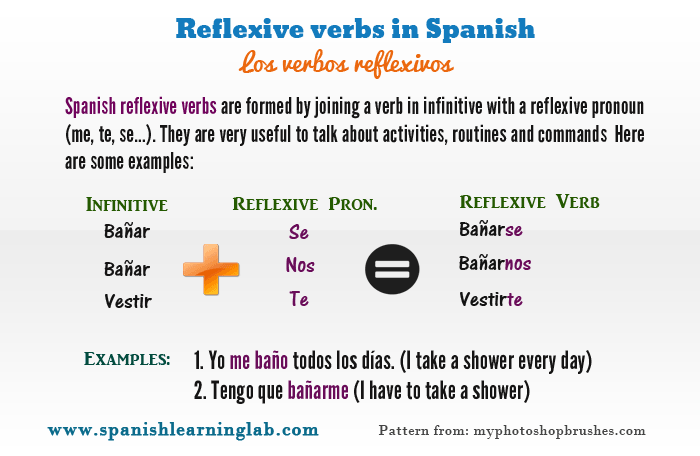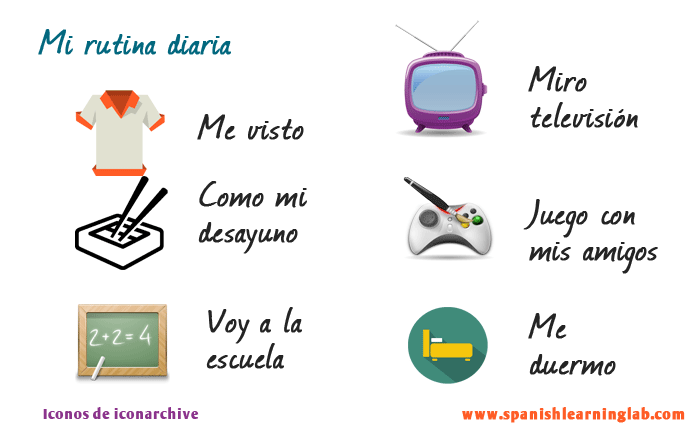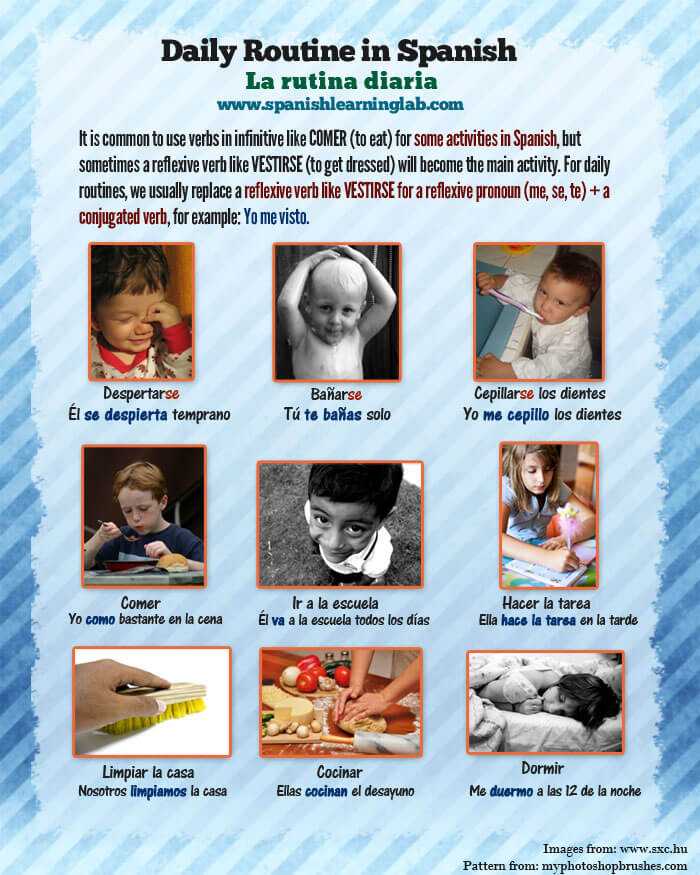Describing Items Using Reflexive Verbs in Spanish
Estás lavándo te los dientes. Since the subject and object are the same the verb is reflexive.
Conocerse to know each other.

. They are reflexive verbs. Also see Reciprocal Actions in Spanish. To get thin to lose weight to grow weak.
Many verbs in Spanish can be reflexive. To be bored get bored. Routines motion emotions reciprocals and verbs that are always reflexive.
Grah-doo-ar-say mudarse to move pronounced. A verb in infinitive a reflexive pronounThe verb in infinite is conjugated following the rules for regular verbs so for a verb like BAÑARSE BAÑAR SE we should apply the rules for AR ending verbs and conjugate that part as Yo baño Tú bañas. Reflexive verbs are also sometimes used to describe an emotional response.
There is one super important tip. They are usually the ones that describe routines or personal care. Se Him Her.
The reflexive verbs Spanish. How to use these Spanish reflexive verbs in a sentence. The Spanish pronouns for reflexive verbs are called object pronouns and are as follows.
What you need to know to form reflexive verbs is a different form of Spanish pronoun. To buy something for oneself. There are five basic categories of reflexive verbs.
To believe to believe oneself. We have the freedom to place the reflexive pronoun either before the first verb or attached at the end of the reflexive verb. In Spanish reflexive verbs or verbos reflexivos are commonly used to talk about motion your own body your clothing your state of mind and your routines.
Abonar to pay money. Spanish verb group Spanish reflexive verb English translation. In the sentences below the subject performs the action on itself and the subject and object of the verb refer to the same entity.
Reflexive verbs are often used to describe things you do to yourself every day for example showering sitting down getting up getting happy and so on. Every morning Brenda wakes Saul up. To get angry to get irritated to get annoyed.
In Spanish reflexive verb format thats. Students will review the uses of verbs correct conjugations and apply their knowledge into a project. Reflexive Pronouns in Use.
Conocer to know. Casarse to get married pronounced. Me myself te yourself se yourself formal himself.
Te alegras de leer It makes you happy to read. The difference between ir and irse isnt. Conjugating Spanish reflexive verbs.
Many actions related to personal care or daily routines are reflexive but other verbs can be reflexive as well. Abonarse to subscribe as to a periodical abrir to open. Callar to be quiet.
Ad Join The Millions Of Users Who Are On Their Way To Speaking A New Language Today. Some verbs such as irse describe motion or movement. These verbs are always recognisable thanks to the particle -se which they have at the end.
This makes sense since all that is really needed for a verb to be reflexive is that it allows the subject and the object to be the same. Cahs-ar-say graduarse to graduate pronounced. Reflexive pronouns use the same forms as indirect object pronouns with the exception of se which is used instead of for the third person.
Casar to marry. When a reflexive verb is used in Spanish it is already understood that the action of the verb is being performed on the subject. Notice the difference between these examples where 1 is using a reflexive form and 2 a non-reflexive verb.
Te estás lavando los dientes. In 1 Brenda wakes herself up while in 2 Brenda performs the action wake up on someone else Saúl. Dressing waking up brushing going to bed calling.
To fall in love to fall for. This lesson provides an overview of Spanish reflexive verb uses and conjugations. There are several types of reflexive verbs in Spanish.
These are verbs that describe daily routines usually surrounding getting up and ready each day such as despertarse peinarse and levantarse. In English we use the pronouns myself yourself himself herself themselves to express the who thats receiving the action. Reflexive verbs are quite common in any Spanish conversation.
Irse to leave. Lets look at some examples of reflexive verbs in English to understand the concept then well start working with Spanish. As a result reflexive verbs may be one of the most difficult topics to learn.
The second verb a reflexive verb in Infinitive or Gerundio. In Spanish use of reflexive verbs is more common than in English and many of these verbs are used in everyday language. However for many people it is difficult to know when you need to use these verbs.
Acordarse to remember. As a general rule reflexive verbs are used when describing an action that you perform and that is going to. To get sick to become ill to fall ill.
Todas las mañanas Brenda despierta a Saúl. As you can see these are very similar to the indirect object pronouns discussed in the earlier episode for use with verbs like gustar. I wash the car.
Those which also have a non-reflexive form with a similar meaning such as. What Are The 5 Reflexive Pronouns In Spanish. As shown in the picture reflexive verbs in Spanish are formed by two parts.
Learn Spanish Easily With The Best App For Language Learning. Both sentences mean I want to take a shower. Irse is a good example of a reflexive verb that changes meaning from its normal form ir.
The English equivalent of this is becoming something eg I became sad or something making you feel a certain way eg I get bored or it makes me happy. Verbs Changing Meaning in Reflexive Form. There is a class or type of verbs which describe the things we do on a daily basis.
Abrirse to open up in the sense of confiding in someone acordar to agree to decide. When to Use Reflexive Verbs in Spanish.

Conjugating And Using Spanish Reflexive Verbs Spanishlearninglab

10 Common Mistakes In Spanish Daily Routines Spanishlearninglab

Sentences With Daily Routine Activities In Spanish Spanishlearninglab

No comments for "Describing Items Using Reflexive Verbs in Spanish"
Post a Comment